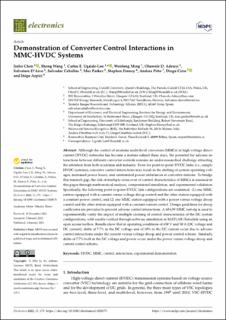| dc.contributor.author | Chen, Jinlei | |
| dc.contributor.author | Wang, Sheng | |
| dc.contributor.author | Ugalde-Loo, Carlos Ernesto | |
| dc.contributor.author | Ming, Wenlong | |
| dc.contributor.author | Adeuyi, Oluwole Daniel | |
| dc.contributor.author | D'Arco, Salvatore | |
| dc.contributor.author | Ceballos, Salvador J. | |
| dc.contributor.author | Parker, Max Alexander | |
| dc.contributor.author | Finney, Stephen Jon | |
| dc.contributor.author | Pitto, Andrea | |
| dc.contributor.author | Cirio, Diego | |
| dc.contributor.author | Azpiri, Iñigo | |
| dc.date.accessioned | 2022-11-18T10:16:08Z | |
| dc.date.available | 2022-11-18T10:16:08Z | |
| dc.date.created | 2022-02-17T11:27:12Z | |
| dc.date.issued | 2022 | |
| dc.identifier.issn | 2079-9292 | |
| dc.identifier.uri | https://hdl.handle.net/11250/3032814 | |
| dc.description.abstract | Although the control of modular multi-level converters (MMCs) in high-voltage directcurrent (HVDC) networks has become a mature subject these days, the potential for adverse interactions between different converter controls remains an under-researched challenge attracting the attention from both academia and industry. Even for point-to-point HVDC links (i.e., simple HVDC systems), converter control interactions may result in the shifting of system operating voltages, increased power losses, and unintended power imbalances at converter stations. To bridge this research gap, the risk of multiple cross-over of control characteristics of MMCs is assessed in this paper through mathematical analysis, computational simulation, and experimental validation. Specifically, the following point-to-point HVDC link configurations are examined: (1) one MMC station equipped with a current versus voltage droop control and the other station equipped with a constant power control; and (2) one MMC station equipped with a power versus voltage droop control and the other station equipped with a constant current control. Design guidelines for droop coefficients are provided to prevent adverse control interactions. A 60-kW MMC test-rig is used to experimentally verify the impact of multiple crossing of control characteristics of the DC system configurations, with results verified through software simulation in MATLAB/Simulink using an open access toolbox. Results show that in operating conditions of 650 V and 50 A (DC voltage and DC current), drifts of 7.7% in the DC voltage and of 10% in the DC current occur due to adverse control interactions under the current versus voltage droop and power control scheme. Similarly, drifts of 7.7% both in the DC voltage and power occur under the power versus voltage droop and current control scheme. Keywords: HVDC; MMC; control; interaction; experimental demonstration | en_US |
| dc.description.abstract | Demonstration of Converter Control Interactions in MMC-HVDC Systems | en_US |
| dc.language.iso | eng | en_US |
| dc.publisher | MDPI | en_US |
| dc.rights | Navngivelse 4.0 Internasjonal | * |
| dc.rights.uri | http://creativecommons.org/licenses/by/4.0/deed.no | * |
| dc.title | Demonstration of Converter Control Interactions in MMC-HVDC Systems | en_US |
| dc.title.alternative | Demonstration of Converter Control Interactions in MMC-HVDC Systems | en_US |
| dc.type | Peer reviewed | en_US |
| dc.type | Journal article | en_US |
| dc.description.version | publishedVersion | en_US |
| dc.rights.holder | The Authors | en_US |
| dc.source.volume | 11 | en_US |
| dc.source.journal | Electronics | en_US |
| dc.source.issue | 2 | en_US |
| dc.identifier.doi | 10.3390/electronics11020175 | |
| dc.identifier.cristin | 2002784 | |
| dc.relation.project | EC/FP7/612748 | en_US |
| dc.source.articlenumber | 175 | en_US |
| cristin.ispublished | true | |
| cristin.fulltext | original | |
| cristin.qualitycode | 1 | |

